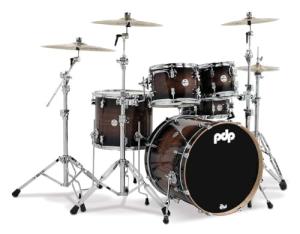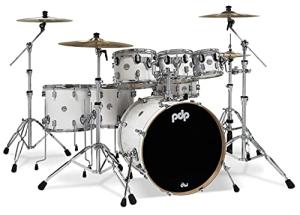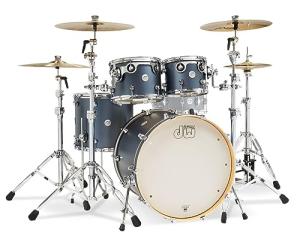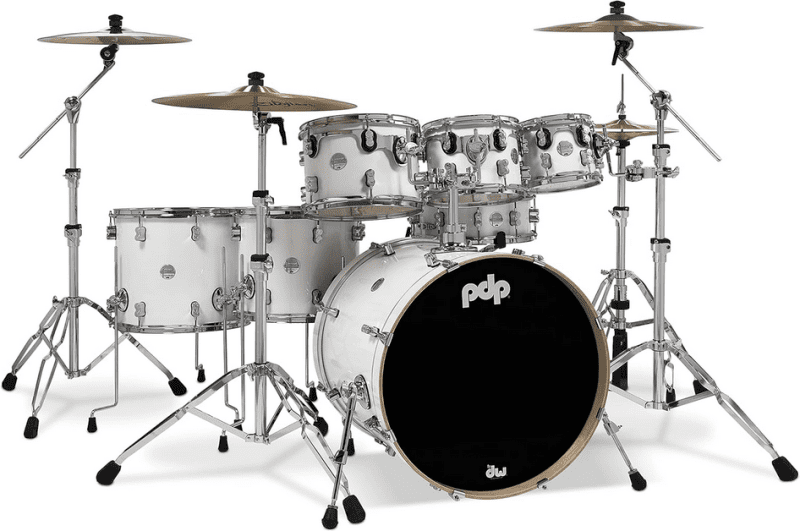Hip-hop music is known for its unique sound, which is heavily influenced by the drums. The rhythm of the drums is a crucial element in hip-hop music, and it plays a significant role in creating the genre's distinctive sound. The drum patterns in hip-hop are complex and syncopated, and they are often the backbone of a song's beat.

The use of drums in hip-hop music has evolved over time, and it has become an essential aspect of the genre. In the early days of hip-hop, drum machines were used to create beats, and they were often programmed to mimic the sound of real drums. As technology advanced, live drums were incorporated into hip-hop music, and they added a new dimension to the genre's sound.
The technical aspects of hip-hop drumming are also important to consider. Drummers must have a keen sense of timing and rhythm to create an authentic hip-hop feel. They must also be able to master the art of groove and incorporate drum fills that add excitement and dynamics to a song. Overall, the role of drums in hip-hop music is significant, and it has helped shape the genre into what it is today.
Key Takeaways
- Drums are a crucial element in hip-hop music, and they play a significant role in creating the genre's distinctive sound.
- The use of drums in hip-hop music has evolved over time, and it has become an essential aspect of the genre.
- Drummers must have a keen sense of timing and rhythm to create an authentic hip-hop feel, and the technical aspects of hip-hop drumming are important to consider.
Historical Evolution of Drums in Hip-Hop
Hip-hop music is known for its distinctive beats and rhythms, which are rooted in the genre's historical evolution. In this section, we will explore the evolution of drums in hip-hop music, from breakbeats to beatmaking, the influence of drum machines and samplers, and the role of live drummers in hip-hop.
From Breakbeats to Beatmaking
Hip-hop music originated in the Bronx in the 1970s, and its early sound was based on breakbeats. A breakbeat is a short section of a song that features a drum break, which is a solo drum performance. DJs would isolate these drum breaks and loop them, creating a new rhythm that dancers could move to. The Sugarhill Gang's "Rapper's Delight" was one of the first hip-hop songs to use a breakbeat, which was sampled from Chic's "Good Times."
As hip-hop evolved, producers began to create their own beats using drum machines and samplers. The E-mu SP-1200 and Akai MPC60 were two popular samplers used in the 1980s and 1990s. These machines allowed producers to sample and manipulate sounds, creating unique drum patterns and rhythms.
Influence of Drum Machines and Samplers
Drum machines and samplers have had a significant impact on the evolution of drums in hip-hop music. They allowed producers to create complex rhythms and experiment with genres beyond traditional boundaries. The use of drum machines and samplers also led to the development of new sub-genres of hip-hop, such as trap and drill.
The Role of Live Drummers in Hip-Hop
While drum machines and samplers have become a staple of hip-hop production, live drummers also play an important role in the genre. Many hip-hop artists incorporate live drumming into their performances, adding a dynamic element to their shows. Live drummers can also bring a unique energy and groove to a hip-hop track that cannot be replicated by a machine.
In conclusion, the historical evolution of drums in hip-hop music has been shaped by a variety of factors, including breakbeats, drum machines, and live drummers. These elements have contributed to hip-hop's distinctive sound and continue to influence the genre today.
Technical Aspects of Hip-Hop Drumming

Drum Patterns and Sequencing
Hip-hop drumming is characterized by its unique and infectious rhythm, which is created by using drum patterns and sequencing techniques. The patterns are often created using digital samplers, and they form the backbone of hip-hop music. Understanding the intricacies of rhythm in hip-hop is essential for drummers looking to excel in this genre. In hip-hop, the drums are often programmed using a sequencer, which allows for precise timing and dynamics.
Sampling and Layering Techniques
Sampling and layering are important techniques in hip-hop drumming. Drum sounds are often sampled from other songs and then layered together to create a unique sound. This process can be done using digital samplers and allows for a wide range of sounds to be used in a single track. The layering technique also allows for the creation of complex rhythms and patterns that are not possible with a single drum sound.
Mixing and EQ Settings for Drums
Mixing and EQ settings are crucial for achieving the desired sound in hip-hop drumming. The drums need to be mixed in a way that they are prominent in the mix, but not overpowering. EQ settings can be used to adjust the tonal balance of the drums, making them sound more natural and balanced. In hip-hop, the drums often have a heavy bass and treble emphasis, which can be achieved through EQ settings.
In conclusion, the technical aspects of hip-hop drumming involve the use of drum patterns and sequencing techniques, sampling and layering, and mixing and EQ settings. These techniques allow for the creation of unique and infectious rhythms that are characteristic of the hip-hop genre. By understanding and mastering these techniques, drummers can excel in the world of hip-hop music.
Cultural Significance and Impact

Drums as a Pillar of Hip-Hop Identity
Drums have always been a significant aspect of music, but in hip-hop, they play a unique role in defining the genre's identity. The rhythmic beats, intricate patterns, and soulful grooves created by hip-hop drumming have become the heartbeat of the genre, captivating audiences worldwide. With its roots in African and African American musical traditions, hip-hop drumming has evolved to become a pillar of hip-hop culture, reflecting the struggles and triumphs of its people.
Influence on Dance and Movement
The impact of hip-hop drumming extends beyond the music and into the realm of dance and movement. The infectious rhythms and beats of hip-hop drumming have inspired a variety of dance styles, including breakdancing, popping, and locking. These dance styles have become an integral part of hip-hop culture, providing a physical expression of the music's emotions and mood.
Contribution to the Global Musical Culture
Hip-hop music, with its unique blend of rhythm, poetry, and social commentary, has become a global phenomenon. Drums have played a significant role in this, as they provide the foundation for the genre's sound. From its origins in the Bronx, New York, hip-hop has spread throughout the world, inspiring new subgenres and contributing to the evolution of musical culture.
In summary, the drums have been an essential part of hip-hop culture since its inception. They provide the genre with its unique identity, inspire dance and movement, and contribute to the global musical culture. Hip-hop drumming reflects the emotions, struggles, and triumphs of its people, making it not just an art form but a reflection of hip-hop culture itself.
Conclusion
In conclusion, drums are a crucial component of hip-hop music and culture. They provide the rhythmic backbone of the music, driving the beat and setting the pace for the rest of the instruments and vocals. Hip-hop artists and producers rely heavily on drums to create the distinctive sound that defines the genre.
The vision of hip-hop music is to tell stories through rhythm and lyrics, and the drums play a vital role in conveying the emotion and energy of these stories. Whether it's a hard-hitting boom bap beat or a more laid-back groove, the drums are essential in setting the tone and mood of the music.
Listening is also an important aspect of hip-hop music, and the drums help to engage the listener and keep them hooked throughout the song. The complex patterns and syncopated rhythms of hip-hop drumming add excitement and dynamics to the music, making it a compelling and engaging listening experience.
Hip-hop artists and producers continue to push the boundaries of what's possible with drums, experimenting with new sounds and techniques to create fresh and innovative music. From classic drum breaks to modern drum machines, the drums remain a fundamental element of hip-hop music, and their importance is unlikely to diminish anytime soon.
Frequently Asked Questions
Why are drums considered a critical element in hip-hop production?
Drums are considered a critical element in hip-hop production because they provide the driving force behind the music. The rhythm and beat of the drums are what make people want to dance and move to the music. In hip-hop, the drums are often the backbone of the track, providing the foundation on which the other elements of the song are built.
What are the common drum patterns used in hip-hop tracks?
The most common drum patterns used in hip-hop tracks are the boom-bap and the trap beat. The boom-bap pattern is characterized by a strong kick drum on the first and third beats of the measure, and a snare on the second and fourth beats. The trap beat, on the other hand, is characterized by a rolling hi-hat pattern, a heavy kick drum, and a snare on the third beat of the measure.
How have hip-hop drum patterns evolved over the years?
Hip-hop drum patterns have evolved significantly over the years. In the early days of hip-hop, the drum patterns were often simple and straightforward, with a focus on the kick and snare. As the genre developed, producers began to experiment with more complex rhythms and patterns, incorporating elements from other genres such as funk, jazz, and rock.
Which specific drums and percussion instruments are most prevalent in hip-hop music?
The most prevalent drums and percussion instruments in hip-hop music are the kick drum, snare drum, hi-hat, and cymbals. These instruments provide the basic rhythm and beat of the track, and are often supplemented by other percussion instruments such as congas, bongos, and timbales.
What techniques are used to create unique drum sounds in hip-hop?
Producers use a variety of techniques to create unique drum sounds in hip-hop. One common technique is to layer multiple drum samples on top of each other to create a thicker, more complex sound. Another technique is to manipulate the pitch and tone of the drum samples, or to add effects such as reverb and distortion.
How do drums contribute to the overall message and feel of a hip-hop song?
Drums contribute significantly to the overall message and feel of a hip-hop song. The rhythm and beat of the drums can create a sense of urgency, excitement, or aggression, depending on the style of the track. In addition, the drums can help to emphasize certain lyrics or themes in the song, and can help to create a sense of unity and cohesion between the different elements of the track.






